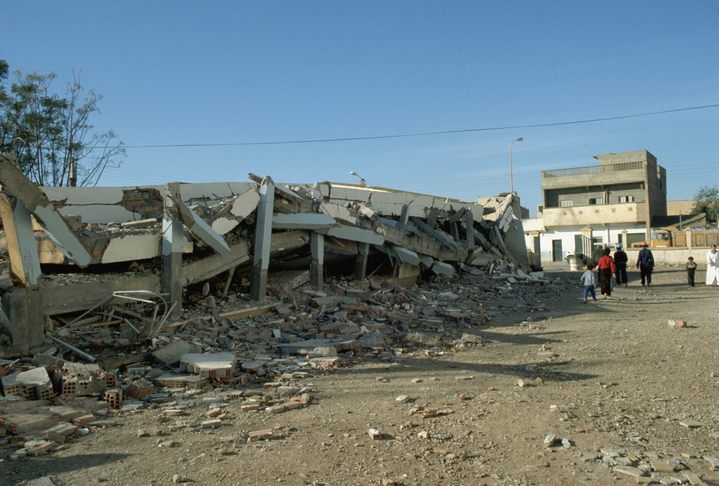Back to Basics is an article series that highlights important but possibly overlooked information facilities management professionals should know.

While some Americans may think earthquakes only happen in California and Hawaii, a recent earthquake in the Northeast and its aftershocks—the biggest earthquake in the area since 1884—prove earthquake preparation is important for everyone, including facilities managers and their employers.
According to the New York Post, the 4.8-magnitude earthquake shook Philadelphia, New York City, and the tristate area on April 5, originating near Lebanon, New Jersey. The U.S. Geological Survey (USGS) reported it was felt by more than 42 million people.
On April 15, WPVI noted at least 51 aftershocks rattled New Jersey after the original earthquake hit.
However, this isn’t uncommon. “[S]ince 1950, 40 other earthquakes of magnitude 3 and larger have occurred within 250km (155.34 miles)” of the New Jersey earthquake, according to the USGS.
What Are Earthquakes?
Ready.gov defines an earthquake as a “sudden, rapid shaking of the ground caused by the shifting of rocks deep underneath the earth’s surface” and cautions that earthquakes can cause fires, tsunamis, landslides, and avalanches.
While scientists can’t predict when or where earthquakes will occur, facilities managers should work with their employers so facilities and their occupants can be protected when they happen.
Importance of Safeguarding Your Facilities
Earthquakes are natural disasters that can impact an organization’s bottom line. For example, the Federal Emergency Management Agency (FEMA) and the U.S. Department of Labor (DOL) reported that 40% of small businesses aren’t able to reopen immediately after an earthquake, and another 25% of small businesses are forced to close within a year.
However, earthquake safety is more than just providing business continuity and protection from property damage. Most importantly, it means protecting lives.
Here are four earthquake safety tips from Ready.gov:
1. Prepare your staff: Develop a business continuity plan that spells out how you will continue to run the organization after an earthquake; create a crisis communications plan that involves identifying audiences and how to reach them, including working with the media; and make employees aware of your plan through training. Facilities managers should work with their employers to check the property’s insurance coverage and create an inventory. Staff should also have access to an emergency first-aid supply kit, a National Oceanic and Atmospheric Administration (NOAA) Weather Radio, and a cellphone weather app with real-time notifications to monitor weather conditions.
2. Check your interior spaces: Assess property in your facility that could cause damage, block exit paths, or hurt people. Strap or Velcro computer monitors, laptops, and desktop computers to desks; affix tall shelving to walls with brackets; secure tall file cabinets to the wall; and install latches to drawers and cabinets. Libraries should brace stacks to the floor and install guards for books. Artwork should be secured to walls with screws, and remember to secure ceiling fans and lights with safety cables. Also, remove all hazardous materials from the business area.
3. Assess utilities and critical components: As for nonstructural earthquake mitigation strategies, check to see if your facility’s built-in partitions and walls are bolted to the building. Be sure to secure the water heater by strap-wrapping it and bolting it to the wall with studs. Consider installing protective film coverings over windows and anchoring and bracing suspended light fixtures, suspended T-bar ceilings, air compressors, piping, and automatic fire sprinkler pipes and heads. Anchor heating, ventilation, and air conditioning (HVAC) equipment and ducts, and reinforce free-standing walls and fences, exterior signs, and roof parapets. Bolt and secure propane and fuel tanks in place, as well.
4. Review your building structure: Facilities managers should first seek the assistance of a structural engineer or design professional to evaluate and design earthquake mitigation measures. Specifically, they should ensure basic building materials are secured and reinforce unreinforced concrete, masonry, and soft story construction materials, as well as cripple walls. Unreinforced brick elements in the building and facades should also be reinforced, and if your facility has concrete tilt-up construction without an anchored roof system, the roof system should be anchored to the walls. Finally, ensure walls that aren’t bolted to the foundation are bolted.
Learn More
For more tips to help you prepare for any type of emergency, including earthquakes, check out “How Facilities and Security Can Work Together for Emergency Preparedness” and “What Should Be in Your Facility’s First-Aid Kit” on Facilities Management Advisor.
